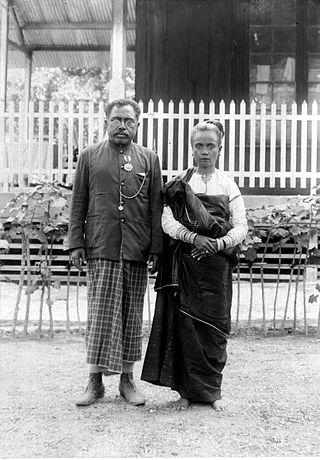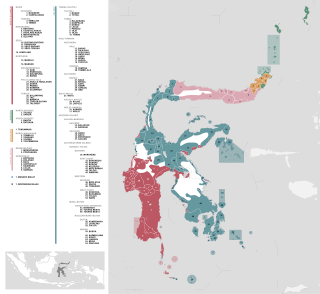
Central Sulawesi is a province of Indonesia located at the centre of the island of Sulawesi. The administrative capital and largest city is located in Palu. The province borders the provinces of Gorontalo to the east, Southeast Sulawesi, South Sulawesi, and West Sulawesi to the south, and sharing maritime borders with East Kalimantan to the west, North Maluku to the east, and Malaysia and the Philippines to the north.

Being an indigenous tribe in Borneo, the Kayan people are similar to their neighbours, the Kenyah tribe, with which they are grouped together with the Bahau people under the Apo Kayan people group. The Kayan people are categorised as a part of the Dayak people. They are distinct from, and not to be confused with, the Kayan people of Myanmar.

The Banggai Regency is a regency located at the eastern end of Central Sulawesi Province of Indonesia. It makes up a re-established regency (kabupaten), created on 4 October 1999 by splitting the existing Banggai Regency into this smaller Banggai Regency situated on the mainland of Sulawesi and a new Banggai Islands Regency comprising the offshore islands to the southeast which are separated from mainland Sulawesi by the Peleng Straits. The residual Banggai Regency covers an area of 9,672.70 km2 and had a population of 323,626 at the 2010 census and 362,275 at the 2020 census; the official estimate as at mid 2023 was 373,693.
Luwuk is the capital of Banggai Regency, Central Sulawesi, Indonesia. Its area is 72.82 km2 following boundary changes in 2012 and 2015. There used to be an oil industry in the region. At the 2020 census the town had a population of 34,849.

Peleng is an island off the east coast of Sulawesi, Indonesia and is the largest island of the Banggai Islands. It is surrounded by the Banda Sea and Molucca Sea and has an area of 2,488.79 km2.

The Sikka people are an Indonesian ethnic group native to the region of east central Flores between the Bloh and Napung Rivers. In the city of Maumere, the center of the region and capital of the Sikka Regency, Sikka people occupy a separate block. The Sikka language, which is a member of the Timor-Ambon languages, is spoken by the Sikka people. The Sikka language has at least three recognized dialects, namely Sikka Natar dialect, Sara Krowe dialect and Ata Tana 'Ai or Sara Tana 'Ai dialect.

The Molucca Sea is located in the western Pacific Ocean, around the vicinity of Indonesia, specifically bordered by the Indonesian Islands of Celebes (Sulawesi) to the west, Halmahera to the east, and the Sula Islands to the south. The Molucca Sea has a total surface area of 77,000 square miles. The Molucca Sea is rich in coral and has many diving sites due to the deepness of its waters. The deepness of the water explains the reasoning behind dividing the sea into three zones, which functions to transport water from the Pacific Ocean to the shallower seas surrounding it. The deepest hollow in the Molucca Sea is the 15,780-foot (4,810-meter) Batjan basin. This region is known for its periodic experiences of earthquakes, which stems from the sea itself being a micro plate, in which the Molucca Sea is being subducted in two opposite directions: one in the direction of the Eurasian Plate to the west and the other in the direction of the Philippine Sea Plate to the east.

The Banggai crow is a member of the crow family from Banggai regency in the province of Central Sulawesi in Indonesia. It is listed as critically endangered by IUCN. It was feared extinct, but was finally rediscovered during surveys on Peleng Island off the southeast coast of Sulawesi by Indonesian ornithologist Mochamad Indrawan in 2007 and 2008.
Koopman's rat is a species of rodent in the family Muridae. It is found only on Peleng island, located in the Banggai Islands off the southeastern coast of Sulawesi, Indonesia.
The Banggai language is the main language spoken by the inhabitants of the Banggai Archipelago off the island of Sulawesi. It belongs to the Saluan–Banggai branch of the Celebic subgroup.

The Manggarai are an ethnic group found in western Flores in the East Nusa Tenggara province, Indonesia. Manggarai people are spread across three regencies in the province, namely the West Manggarai Regency, Manggarai Regency, and East Manggarai Regency.
The Saluan–Banggai languages are a group of closely related languages spoken in eastern Central Sulawesi province, Indonesia. They belong to the Celebic subgroup of the Austronesian family.

On the Indonesian island of Sulawesi, 114 native languages are spoken, all of which belong to the Malayo-Polynesian subgroup of the Austronesian language family. With a total number of 17,200,000 inhabitants, Sulawesi displays a high linguistic diversity when compared with the most densely populated Indonesian island Java, which hosts 4–8 languages spoken by 145,100,000 inhabitants.
Pakasua is a village in the island of Banggai in Banggai district, Banggai Laut, Central Sulawesi province. The village is part of the Kokini with its neighbors, Lelang village.

Banggai Sea Regency is a regency in the province of Central Sulawesi, Indonesia. The regency was established on 14 December 2012, partitioned from the Banggai Islands Regency. It comprises the southern part of the Banggai Islands archipelago, including the main island of Banggai itself, the islands of Labobo and Bangkurung to the southwest of Banggai Island, and the numerous small Bokan Islands to the southeast; it does not include the larger island of Peleng to the north which forms the Banggai Islands Regency. The new Banggai Sea Regency covers a land area of 725.67 km2, and the districts now comprising the new Regency had a population of 62,183 at the 2010 Census and 70,435 at the 2020 Census; the official population estimate at mid-2023 was 73,100.

Ot Danum people are an ethnicity of the Dayak peoples dwelling at the upper reaches of south Kapuas River, and along the Schwaner range, bordering West Kalimantan and Central Kalimantan, Indonesia. They are the most important group of the upper Melawi River and culturally and linguistically the most distinct from the Malay people. Besides, the Malay people, the Ot Danum people are also linguistically distinct from the Ngaju people who live along the middle reaches of Central Kalimantan's great rivers and who are numerically and linguistically the dominant Dayak people group in the area. Just like most Dayak people group, majority of the Ot Danum people also practice Kaharingan religion.

The Kingdom of Banggai was a petty kingdom in present-day Central Sulawesi, Indonesia. It was based around the Banggai Islands and the eastern coast of Sulawesi, centered at the island of Banggai. For a significant part of its history, the kingdom was under the overlordship of the Sultanate of Ternate. Its' rulers held the title of Raja.
On 4 May 2000 at 12:21 WITA, a 7.5 earthquake struck off the coast of Banggai Islands Regency, Central Sulawesi, Indonesia, which was followed by a damaging local tsunami. The earthquake and tsunami killed at least 54 people and injured 270 others, with most of the damage and casualties occurring in the Banggai Islands.
Banggai people is an ethnic group inhabited almost whole part of Banggai Islands Regency, Banggai Sea Regency, and parts of Banggai Regency.
Balantak is an ethnic group residing in Banggai Regency, Central Sulawesi, Indonesia. The Balantak community is divided into two sub-ethnic groups: the Tanoturan and the Dale-Dale. Most Balantak people in Banggai live on the East Peninsula.












